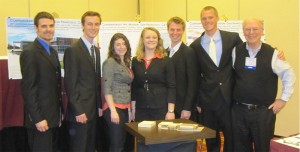A team of six Drexel engineering and architecture students won three awards for their senior design project at the second annual American Society of Civil Engineers Charles Pankow Foundation Annual Architectural Engineering Student Competition March 31 in Oakland, Calif.

The Architectural Engineering Institute of ASCE held the final round of the competition in unison with the 2011 Architectural Engineering Conference. As the ASCE website states, the competition places emphasis on the “integration of the engineered systems for a high-performance building, collaboration, competition and peer review, all of which are important in the development of designs in the professional world.”
Asked to design a Contemporary Art Museum for the Presidio in the San Francisco Bay area, the teams of interdisciplinary engineering students had to strive for environmental stability in their designs and address the challenges of constructing a high-performance building in a seismically active area.
Students from universities across the nation were able to submit projects for up to four categories in addition to the primary building integration category, for which all teams were required to submit a project. They were “encouraged to work together in multi-disciplinary teams” to “consider how the engineered systems work with or enhance the architecture of the building,” according to the ASCE website.
Alex Stadel, a civil and architectural engineering major and team leader for the project, found the interdisciplinary aspect of the competition to be crucial to the team’s success.
“This competition was a great opportunity, and I found it extremely rewarding to work in conjunction with students from various disciplines; the collaboration was the reason for our success. I feel that it’s important for students to participate in design competitions and compete against other schools – it builds a certain school pride and motivates us to strive for more,” Stadel said.
Heading into the competition, the Drexel team had to quickly familiarize themselves with new and unfamiliar computer programs. Achey, an architectural engineering major with a concentration in mechanical engineering, said he found the experience challenging, but rewarding.
“It was interesting to work with programs outside of my comfort level. Though stressful at times, Mike [Snader] and I spent nights learning the programs, such as eQUEST and AutoCAD Revit, before we could actually make progress,” Achey said.
Serving as the faculty adviser for the project, Drexel professor James Mitchell initially encouraged the students to participate in the competition. He attended the competition, though not required, to show his support for the Drexel team.
Snader, a mechanical engineering major, said, “It was definitely an experience to be given a floor plan that we had to reorganize and design all [mechanical, structural, fire protection and plumbing] systems. We put a lot of sleepless nights into this project and it was great to come out on top.”
The team was awarded $1,000 for first place in building integration and an additional $400 for the structural and mechanical categories, totaling $1,800 for the team.


